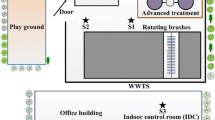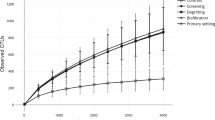Abstract
Purpose
Bacterial community structure and the chemical components in aerosols caused by rotating brushes in an Orbal oxidation ditch were assessed in a Beijing municipal wastewater treatment plant.
Methods
Air samples were collected at different distances from the aerosol-generating rotating brushes. Molecular culture-independent methods were used to characterize the community structure of the airborne bacteria in each sample regardless of cell culturability. A clone library of 16S rDNA directly amplified from air DNA of each sample was constructed and sequenced to analyze the community composition and diversity. Insoluble particles and water-soluble ions emitted with microorganisms in aerosols were analysis by a scanning electron microscope together with energy dispersive X-ray spectroscopy and ion chromatogram analyzer.
Results
In total, most of the identified bacteria were Proteobacteria. The majority of sequences near the rotating brushes (the main source of the bioaerosols) were Proteobacteria (62.97 %) with β-(18.52 %) and γ-(44.45 %) subgroups and Bacteroidetes (29.63 %). Complex patterns were observed for each sampling location, suggesting a highly diverse community structure, comparable to that found in water in the Orbal oxidation ditch. Accompany with microorganisms, 46.36 μg/m3 of SO 2−4 , 29.35 μg/m3 of Cl−, 21.51 μg/m3 of NO −3 , 19.76 μg/m3 of NH +4 , 11.42 μg/m3 of PO 3−4 , 6.18 μg/m3 of NO −2 , and elements of Mg, Cl, K, Na, Fe, S, and P were detected from the air near the aerosols source.
Conclusions
Differences in the structure of the bacterial communities and chemical components in the aerosols observed between sampling sites indicated important site-related variability. The composition of microorganisms in water was one of the most important sources of bacterial communities in bioaerosols. Chemical components in bioaerosols may provide a media for airborne microorganism attachment, as well as a suitable microenvironment for their growth and survival in the air. This study will be benefit for the formulation of pollution standards, especially for aerosols, that take into account plant workers’ health.










Similar content being viewed by others
References
Alvarez AJ, Buttner MP, Toranzos GA, Dvorsky EA, Toro A, Heikes TB, Mertikas-Pifer LE, Stetzenbach LD (1994) Use of solid-phase PCR for enhanced detection of airborne microorganisms. Appl Environ Microbiol 60:374–376
Amann RI, Ludwig W, Schleifer KH (1995) Phylogenetic identification and in situ detection of individual microbial cells without cultivation. Microbiol Mol Biol R 59:143–169
An HR, Mainelis G, White L (2006) Development and calibration of real-time PCR for quantification of airborne microorganisms in air samples. Atmos Environ 40:7924–7939
Ansede JH, Friedman R, Yoch DC (2001) Phylogenetic analysis of culturable dimethyl sulfide-producing bacteria from a Spartina-dominated salt marsh and estuarine water. Appl Environ Microbiol 67:1210–1217
Buttner MP, Cruz-Perez P, Stetzenbach LD (2001) Enhanced detection of surface-associated bacteria in indoor environments by quantitative PCR. Appl Environ Microbiol 67:2564–2570
Carducci A, Tozzi E, Rubulotta E, Casini B, Cantiani L, Rovini E, Muscillo M, Pacini R (2000) Assessing airborne biological hazard from urban wastewater treatment. Water Res 34:1173–1178
China Bureau of Environmental Protection (2002) Water and wastewater monitor and analysis method (4th). China Environmental Science, Beijing, pp 279–281
Cruz-Perez P, Buttner MP, Stetzenbach LD (2001) Detection and quantitation of Aspergillus fumigatus in pure culture using polymerase chain reaction. Mol Cell Probes 15:81–88
Dimmick RL, Wolochow H, Chatigny MA (1979) Evidence that bacteria can form new cells in airborne particles. Appl Environ Microbiol 37:924–927
Ding Y, Wu WX, Han ZY, Chen YX (2008) Correlation of reactor performance and bacterial community composition during the removal of trimethylamine in three-stage biofilters. Biochem Eng J 38:248–258
Fannin KF, Vana SC, Jakubowski W (1985) Effect of an activated sludge wastewater treatment plant on ambient air densities of aerosols containing bacteria and viruses. Appl Environ Microbiol 49:1191–1196
Good IJ (1953) The population frequencies of species and the estimation of population parameters. Biometrika 40:237–264
Grisoli P, Rodolfi M, Villani S, Grignani E, Cottica D, Berri A, Picco AM, Dacarro C (2009) Assessment of airborne microorganism contamination in an industrial area characterized by an open composting facility and a wastewater treatment plant. Environ Res 109:135–142
Han SF, Liu YC, Zhou ZG, He SX, Cao YN, Shi PJ, YaoB RE (2010) Analysis of bacterial diversity in the intestine of grass carp (Ctenopharyngodon idellus) based on 16S rDNA gene sequences. Aquac Res 42:47–56
Higgins JA, Cooper M, Schroeder-Tucker L, Black S, Miller D, Karns JS, Manthey E, Breeze R, Perdue ML (2003) A field investigation of Bacillus anthracis contamination of US Department of Agriculture and other Washington, D.C., buildings during the anthrax attack of October 2001. Appl Environ Microbiol 69:593–599
Holland SM (2003) Analytic rarefaction 1.3. Available at http://www.uga.edu/strata/software/ anRareReadme.html.
Li L, Gao M, Liu JX (2011) Distribution characterization of microbial aerosols emitted from a wastewater treatment plant using the Orbal oxidation ditch process. Process Biochem 46:910–915
Mao HY, Tian G, Huang YH, Li G, Song GW (2011) Mass size distributions and existing forms of sulfate and nitrate at atmospheric environment in Beijing (in Chinese). Environ Sci 32:1237–1241
Maron P-A, Lejon DPH, Carvalho E, Bizet K, Lemanceau P, Ranjard L, Mougel C (2005) Assessing genetic structure and diversity of airborne bacterial communities by DNA fingerprinting and 16S rDNA clone library. Atmos Environ 39:3687–3695
Moletta M, Delgenes JP, Godon JJ (2007) Differences in the aerosolization behavior of microorganisms as revealed through their transport by biogas. Sci Total Environ 379:75–88
Orsini M, Laurenti P, Boninti F, Arzani D, Ianni A, Romano-Spica V (2002) Research note. A molecular typing approach for evaluating bioaerosol exposure in wastewater treatment plant workers. Water Res 36:1375–1378
Pace NR (1997) A molecular view of microbial diversity and the biosphere. Science 276:734–740
Palmer CJ, Bonilla GF, Roll B, Paszko-Kolva C, Sangermano LR, Fujioka RH (1995) Detection of Legionella species in reclaimed water and air with the environAmp Legionella PCR kit and direct fluorescent antibody staining. Appl Environ Microbiol 61:407–412
Pascual L, Pérez-Luz S, Yáñez MA, Santamaría A, Gibert K, Salgot M, Apraiz D, Catalán V (2003) Bioaerosol emission from wastewater treatment plants. Aerobiologia 19:261–270
Pearson MM, Sebaihia M, Churcher C, Quail MA, Seshasayee AS, Luscombe NM, Abdellah Z, Arrosmith C, Atkin B, Chillingworth T, Hauser H, Jagels K, Moule S, Mungall K, Norbertczak H, Rabbinowitsch E, Walker D, Whithead S, Thomson NR, Rather P, Parkhill NJ, Mobley HLT (2008) Complete genome sequence of uropathogenic Proteus mirabilis, a master of both adherence and motility. J Bacteriol 190:4027–4037
Pillai SD, Ricke SC (2002) Bioaerosols from municipal and animal wastes: background and contemporary issues. Can J Microbiol 48:681–696
Polymenakou PN, Mandalakis M, Stephanou EG, Tselepides A (2008) Particle size distribution of airborne microorganisms and pathogens during an intense African dust event in the eastern Mediterranean. Environ Health Perspect 116:292–296
Ranalli G, Principi P, Sorlini C (2000) Bacterial aerosol emission from wastewater treatment plants: culture methods and bio-molecular tools. Aerobiologia 16:39–46
Rintala H, Hyvärinen A, Paulin L, Nevalainen A (2004) Detection of Streptomycetes in house dust—comparison of culture and PCR methods. Indoor Air 14:112–119
Sánchez-Monedero MA, Aguilar MI, Fenoll R, Roig A (2008) Effect of the aeration system on the levels of airborne microorganisms generated at wastewater treatment plants. Water Res 42:3739–3744
Sawyer MH, Chamberlin CJ, Wu YN, Aintablian N, Wallace MR (1994) Detection of Varicella-zoster virus DNA in air samples from hospital rooms. J Infect Dis 169:91–94
Schafer MP, Martinez KF, Mathews ES (2003) Rapid detection and determination of the aerodynamic size range of airborne Mycobacteria associated with whirlpools. Appl Occup Environ Hyg 18:41–50
Stetzenbach LD, Buttner MP, Cruz P (2004) Detection and enumeration of airborne biocontaminants. Curr Opin Biotechnol 15:170–174
Wickman HH (1994) Deposition, adhesion and release of bioaerosols. In: Lighthart B, Mohr AJ (eds) Atmospheric microbial aerosols, theory and applications. Chapman & Hall, New York, pp 99–165
Williams RH, Ward E, McCartney HA (2001) Methods for integrated air sampling and DNA analysis for detection of airborne fungal spores. Appl Environ Microbiol 67:2453–2459
Yao XH, Lau APS, Fang M et al (2003) Size distributions and formation of ionic species in atmospheric particulate pollutants in Beijing, China: 1-inorganic ions. Atmos Environ 37:2991–3000
Acknowledgments
We appreciate Wenjie Ding for his help in sequence alignment and Dr. Watts for the English revision of the manuscript. We also appreciate the University of Georgia Stratigraphy Lab for providing the software (Analytic Rarefaction 1.3) in rarefaction calculations. The work was financially supported by the National Natural Science Foundation of China (no. 51178451 and 51138009).
Author information
Authors and Affiliations
Corresponding author
Additional information
Responsible editor: Philippe Garrigues
Rights and permissions
About this article
Cite this article
Han, Y., Li, L., Liu, J. et al. Microbial structure and chemical components of aerosols caused by rotating brushes in a wastewater treatment plant. Environ Sci Pollut Res 19, 4097–4108 (2012). https://doi.org/10.1007/s11356-012-0885-1
Received:
Accepted:
Published:
Issue Date:
DOI: https://doi.org/10.1007/s11356-012-0885-1




